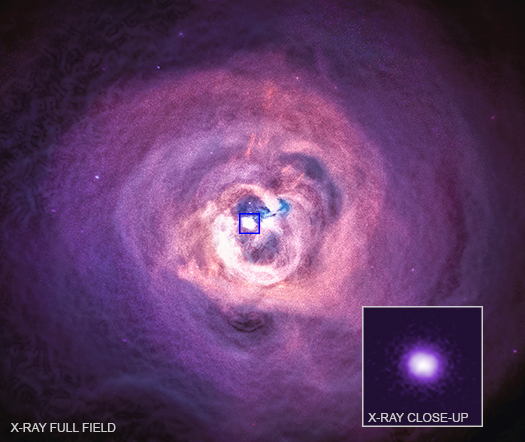Astronomers test string theory using NASA's Chandra X-ray space telescope
Astronomers have probed the Perseus galaxy cluster in search of an (so far) undetected particle that would help to support string theory.
String theory is the idea that all known forces, particles and interactions can be connected through a single framework to understand the physical universe. A team of astronomers using NASA's Chandra X-ray Observatory studied galaxy clusters — the largest structures in the universe held together by gravity — for signs of an ultra-low-mass particle called an axion, which many models of string theory predict should exist.
"While it may sound like a long shot to look for tiny particles like axions in gigantic structures like galaxy clusters, they are actually great places to look," David Marsh, co-author of the study from Stockholm University in Sweden, said in a statement from the Chandra X-ray Observatory.
Related: 7 surprising things about the universe
Axion particles are believed to have incredibly low masses, potentially ranging from a millionth of the mass of an electron down to zero mass. The team also looked for signs of "axion-like particles," which are a broader class of ultra-low-mass particles with similar properties to axions, according to the statement.
Additionally, these ultra-low-mass particles may sometimes convert into photons — the particles that make up light — when they pass through magnetic fields. In turn, photons may also convert into axions under certain conditions. Both scenarios depend on the mass of the particles and how easily they can make the conversion, also known as convertibility, according to the statement.
As part of this new study, astronomers using the Chandra space telescope studied the spectrum of X-ray emissions produced by material falling towards the supermassive black hole at the center of the Perseus galaxy cluster.
Breaking space news, the latest updates on rocket launches, skywatching events and more!
"Galaxy clusters contain magnetic fields over giant distances, and they also often contain bright X-ray sources," Marsh said in the statement. "Together these properties enhance the chances that conversion of axion-like particles would be detectable."
However, the team did not detect any distortions in the X-ray emissions that would indicate axion-like particles were present, according to the statement.
"Our research doesn't rule out the existence of these particles, but it definitely doesn't help their case," Helen Russell, co-author of the study from the University of Nottingham in the UK, said in the statement. "These constraints dig into the range of properties suggested by string theory, and may help string theorists weed their theories."
One possible explanation for these recent observations is that the particles have either a lower or higher convertibility than the Chandra space telescope is able to detect, the researchers said.
"Until recently I had no idea just how much X-ray astronomers bring to the table when it comes to string theory, but we could play a major role," Christopher Reynolds, lead author of the study from the University of Cambridge in the United Kingdom, said in the statement. "If these particles are eventually detected it would change physics forever."
Their findings were published Feb. 10 in The Astrophysical Journal.
- The universe may be flooded with a cobweb network of invisible strings
- The Universe: From the Big Bang to now in 10 easy steps
- Did this newfound particle form the universe's dark matter?
Follow Samantha Mathewson @Sam_Ashley13. Follow us on Twitter @Spacedotcom and on Facebook.
OFFER: Save at least 56% with our latest magazine deal!
All About Space magazine takes you on an awe-inspiring journey through our solar system and beyond, from the amazing technology and spacecraft that enables humanity to venture into orbit, to the complexities of space science.

Samantha Mathewson joined Space.com as an intern in the summer of 2016. She received a B.A. in Journalism and Environmental Science at the University of New Haven, in Connecticut. Previously, her work has been published in Nature World News. When not writing or reading about science, Samantha enjoys traveling to new places and taking photos! You can follow her on Twitter @Sam_Ashley13.


